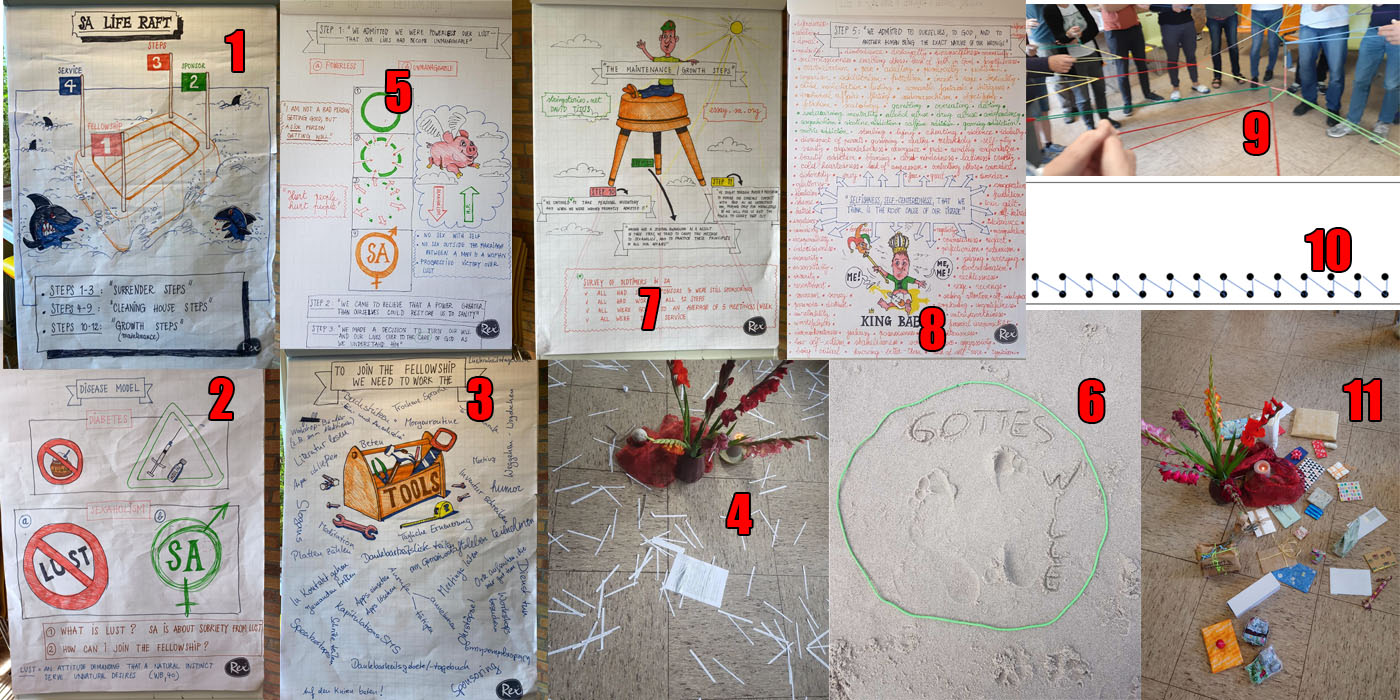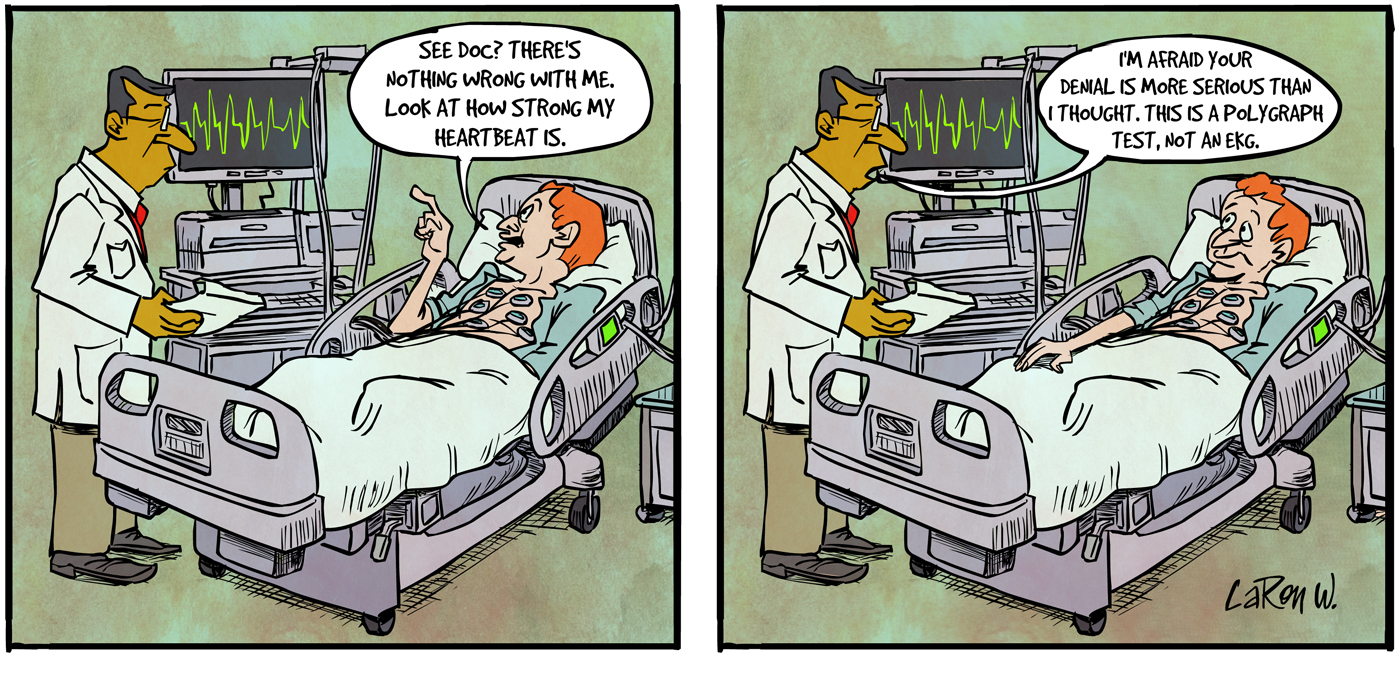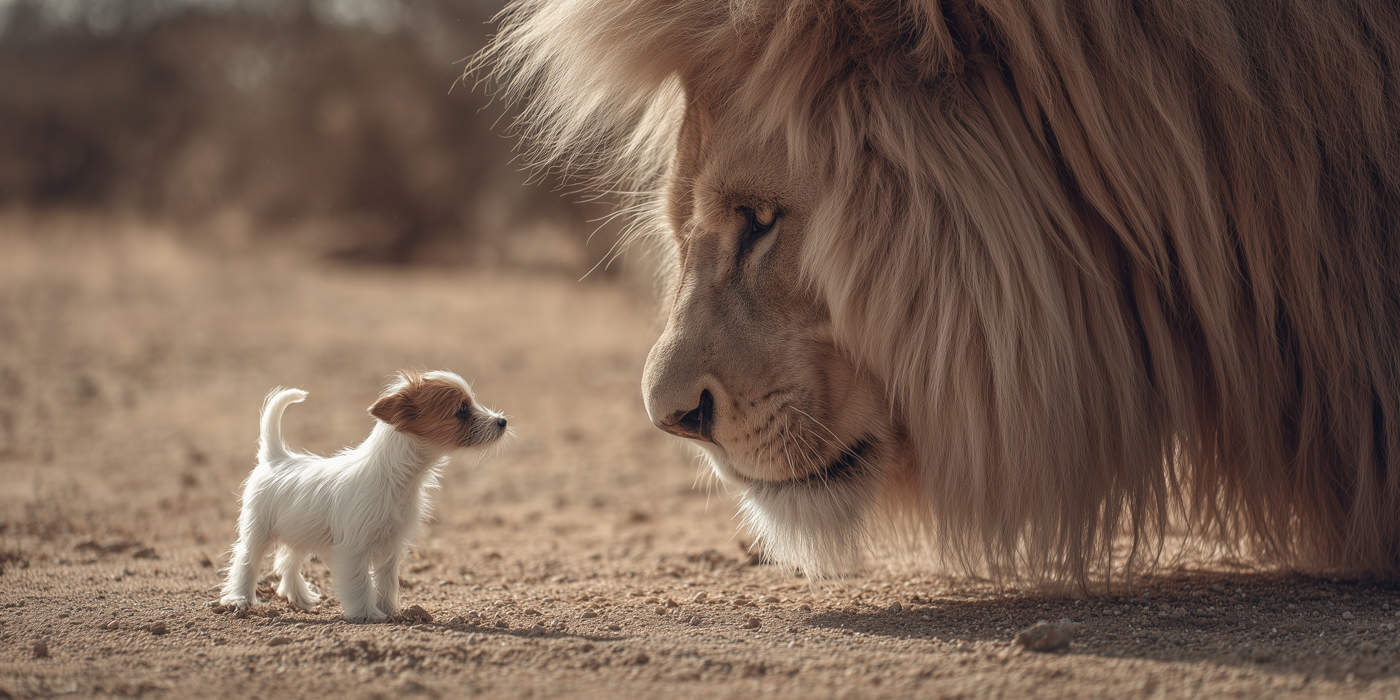
Some months ago, our Bonn group hosted a 12-Step workshop with 31 participants. It was a creative combination of Dave T.’s awesome string exercises., Nicholas S.’s brilliant 12-Step workshop, and the workshop leader’s live drawings on a flipchart.
Image 1 shows how to live life in a sea full of sharks representing lust. Fellowship, Sponsor, Steps, and Service are the four indispensable conditions to be on the life raft. We were asked where we were in relation to the raft: Somewhere on the edge? With one foot in and the second out? In the middle? Or somewhere out in the ocean? This was also experienced during a group dynamic exercise, where we were asked to stand up and position ourselves in relation to the life raft.
Image 2 makes it clear that a person with diabetes needs to avoid sugar in all its forms and to take insulin. He cannot afford to stop taking insulin when his blood sugar is within a healthy range. In the same way, we cannot—after some time of sobriety—afford to stop using the “SA fellowship” as indispensable medication and rest on our laurels.
In another exercise (see image 3) the whole group brainstormed on the tools of the program, which were listed criss-cross on the flipchart sheet. I was astonished to see the real treasury of tools I have at my disposal. I am truly not a victim anymore. In recovery, I am still as powerless as before but certainly not helpless anymore. There are more tools than I can work on any given day.
Image 4 shows snippets on the floor. Everyone received a paper containing the 20 Questions (SA 8). Each time we answered a question positively, we had to tear off the strip containing that question and throw it on the floor. The many snippets on the floor symbolized the wreckage we had caused, or still cause, in our lives through our addiction, which created a very strong and confronting image.
The four circles drawn on image 5 were very enlightening to me:
Circle 1 shows an unbroken green circle, representing our unbroken boundaries when we entered this world as little babies.
Circle 2 shows a broken green circle, depicting the destruction of our boundaries by all kinds of—emotional, physical, sexual, spiritual—abuse and neglect caused upon us by other people in our childhood.
The even more destroyed green circle 3 represents the abuse and violations we ourselves did to others and to ourselves, thus further destroying our “already destroyed boundaries.”
Circle 4 shows SA reinstalling the boundaries we had as babies by means of the clear boundaries of the SA sobriety definition and the strength of the Fellowship.
I related to the workshop leader who shared how he had tried “committed relations” as well as same-sex acting out, which for him had led time and again to disaster and almost suicide. His original boundaries have been destroyed so severely and his disease is so strong that he needs our clear and strong sobriety definition as it is in order to stay sober and grow in recovery.
The powerful string exercise on image 6 exercise was all about the difference between “being in God’s love for me” and “being in His will for me.” Each of us had gotten a “string”—a colored nylon ribbon—at the beginning of the weekend. In this particular exercise we were asked to put it on the ground in front of us and to stand in the middle of it. The circle symbolized the will of God. Standing in the middle of the circle represented living in harmony with God’s will for us.
Then we were invited to put one foot out and to feel the inner division, the double life. Next, to leave the circle and turn our backs to it, and to see how we felt now. Then, to go to the opposite of the room with the circle at our backs—the place of our deepest disconnection from God, the place of our deepest acting out, of complete self-will and selfishness. How did we feel now? What did we experience in this place of utter darkness and addiction? Then, to go into the circle of someone else—codependently trying to live someone else’s life instead of our own—and to observe our inner feelings. And finally, to go back into our own circle.
No matter where we stood, we were always in the middle of God’s love for us—in our circle as well as out of it. But by being also in the middle of His will for me was the only place where I felt incredibly wholesome, right, peaceful, and happy.
Image 7 shows a three-legged stool, showing the importance of Steps 10, 11, and 12, also called the “Maintenance Steps” or the “Growth Steps.” With only one or two legs the stool is unstable and doomed to fall, but if all three legs are solid, we can sit very comfortably on the stool. A nice detail, depicted by the red lines under the legs, is that the legs of the stool keep growing if I continue to work.
The Big Book says “Selfishness—self-centeredness! That, we think, is the root of our troubles” (AA 62). Image 8 shows in a most shocking way that each and every one of the endless list of character defects on the flipchart sheet originates from selfishness and self-centeredness.
The string exercise shown on image 9 showed us the strength of the fellowship. The workshop leader guided us to perform small tricks with the nylon strap. The interconnectedness of all the fellows in the fellowship was symbolized by the web of strings. When a person relapses or decides to leave the fellowship, it has significant consequences for the fellowship. It causes a ripple effect, affecting the individual group, intergroups, countries, and the worldwide fellowship.
In another strong group dynamics exercise, we stood next to each other in pairs—represented by the dots in image 10. Each fellow asked his/her neighbor to put his/her hand on his/her shoulder, which is what the lines in between the dots represent. The longest sober members stood at the first places, followed by the next in sobriety, and so on. Everyone looked in the direction of the longest sober members, who in turn looked straight ahead towards “recovery.”
Next, the workshop leader grabbed a cushion and personified lust—extremely angry with all those who were sober and working the program. He asked someone to leave the rows and stand on his own. Then, he attacked him with the cushion. Being defenseless, the fellow fell to the ground. The act was repeated a couple of times. (We didn’t know that they had pre-arranged this.) After this, the friend joined the rows of pairs and interconnected with those next to him and before him by putting his hand on their shoulder. Now, lust attacked again with the pillow, but to now avail: the fellowship stood like a “rock.”
We did several other strong string exercises—some individually, some in pairs, others in group—and confronting group dynamics exercises.
Image 11 shows how each of the 31 participants had been asked to bring a wrapped recovery gift. These gifts had been laying during the weekend in the middle of the room. At the closing section each could choose one, which was a lot of fun.
But probably the greatest gift of the workshop for me was the invisible gift of having been given new experience, strength, and hope, as well as a new willingness to be honest and have a “zero tolerance attitude” towards taking drinking looks in any way. This invisible gift is incomparably more powerful and loving than the invisible monster that is still inside me and wants to seduce me and possess me. It is quite angry with me, because I have been full of new courage since the workshop.
Winfried, Windeck, Germany






